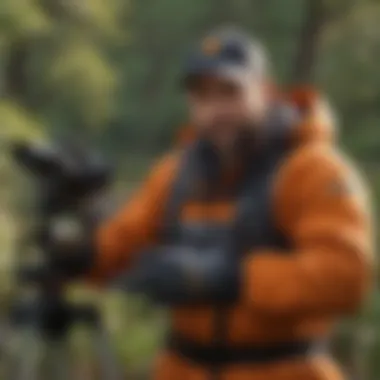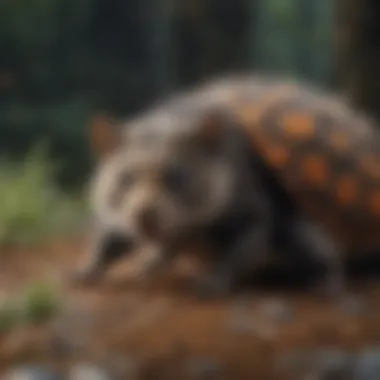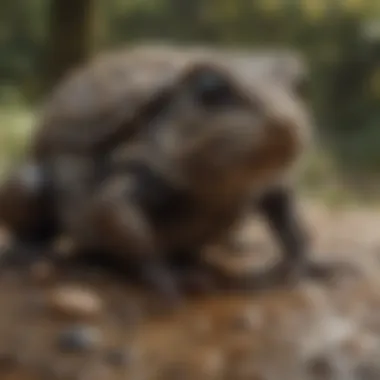A Comprehensive Guide to A1 Wildlife Removal


Intro
Understanding wildlife removal is essential for homeowners today. Many people encounter issues with wildlife in urban areas. Whether it is raccoons in the garbage or squirrels in the attic, each situation requires careful handling. This guide will provide insights on humane removal techniques and prevention methods. Also, it will inform readers about how to deal with wildlife responsibly.
Wildlife can pose risks, both to property and personal safety. Therefore, recognizing the importance of effective management is crucial. This guide targets homeowners wishing to learn more about dealing with unwanted wildlife. It aims to provide practical solutions that prioritize both effectiveness and humane treatment, ensuring a balanced approach to wildlife interactions.
Pest Identification
One of the first steps in managing wildlife is proper identification. Knowing what kind of pests are present can significantly influence the removal methods employed. Different animals have unique behaviors, habitats, and signs associated with them.
Common Household Pests
Some of the most common household pests include:
- Raccoons
- Squirrels
- Opossums
- Skunks
- Bats
Identifying these pests is the first step in understanding their habits and the potential damage they may cause.
Signs of Infestation
Recognizing the signs of wildlife infestation allows homeowners to intervene promptly. Common indicators include:
- Nocturnal noises in the attic or walls.
- Feces or urine near entry points or nests.
- Damaged insulation or entry holes.
- Scattered trash or overturned items outside.
If you observe any of these signs, it may indicate an infestation that needs management. Ignoring these can lead to greater problems, such as property damage or health risks.
Foreword to Wildlife Removal
Wildlife removal is an essential aspect of maintaining safety and order in residential areas. As urbanization continues to expand, wildlife encounters within cities have become increasingly common. Understanding how to manage these encounters effectively is crucial for homeowners. Not only does wildlife removal prevent property damage, but it also protects the residents from potential health risks associated with wildlife infestations.
The key elements to consider regarding wildlife removal include recognizing the signs of wildlife presence, understanding the local wildlife ecosystem, and knowing when and how to take corrective action. Effective wildlife management emphasizes humane methods that align with ethical standards, contributing to the overall well-being of both humans and animals.
Understanding Wildlife in Urban Areas
Urban areas provide unique habitats for various wildlife species. Animals like raccoons, squirrels, and even bats often find their way into city landscapes due to the availability of food, shelter, and nesting sites. Understanding this dynamic is critical for homeowners.
Wildlife adapts to urban ecosystems by exploiting resources left behind by human activity. For instance, discarded food in waste bins or open garbage can attract rodents. Such patterns can lead to increased wildlife activity around homes, raising the risk of an infestation. Furthermore, buildings present numerous entry points, making it imperative to identify and address vulnerabilities early.
The Role of Wildlife Removal Services
Wildlife removal services play a pivotal role in addressing the challenges posed by urban wildlife. These professionals are trained to handle wildlife encounters with a focus on humane practices. They assess the situation thoroughly, identifying species, entry points, and possible risks associated with the presence of wildlife in or around homes.
Using their expertise, wildlife removal services can implement effective removal strategies, ensuring the animals are relocated safely rather than exterminated. Furthermore, they provide valuable insight into long-term prevention measures. Their involvement helps to mitigate recurrence, which is crucial for maintaining a peaceful coexistence between humans and wildlife in urban settings.
"Prompt action and professional insight can significantly reduce the risks associated with urban wildlife."
Common Types of Wildlife Encountered
Understanding common wildlife species encountered in urban settings is crucial for effective wildlife management. Different animals present unique challenges and risks to homes. Recognizing these creatures, and their behaviors can help homeowners and pest control professionals take appropriate action.
As we explore various wildlife types, we also touch on their potential impacts. This knowledge enables effective communication when discussing wildlife issues with service providers or within community settings.
Rodents
Rodents, such as mice and rats, are among the most common urban wildlife. They adapt well to human environments, often finding shelter in attics, basements, and crawl spaces.
They reproduce quickly. A small infestation can turn into a serious problem in a short time. Rodents carry diseases, including hantavirus and leptospirosis, which can be harmful to humans. Their chewing habits pose risks to wiring and insulation, leading to potential fire hazards. Homeowners should remain vigilant by monitoring signs of their presence, such as droppings or gnaw marks.
Birds


Birds can also become problematic in urban areas. Pigeons and starlings are often seen in large numbers. These species may damage property and create unsightly messes due to droppings. Moreover, some birds can carry diseases, which may affect humans and pets.
Methods of deterring birds include installing spikes or nets on building ledges. Understanding their nesting habits can also guide prevention efforts.
Raccoons
Raccoons are highly adaptable creatures often seen foraging in trash bins or rummaging through gardens. Their dexterous paws allow them to open containers and doors, making them a serious nuisance.
They can also carry rabies and other diseases, posing risks to pets and humans alike. Homeowners should secure garbage and close entry points to avoid raccoon encounters. Early identification of raccoon activity can prevent larger issues down the road.
Bats
Bats are typically perceived as harmless. However, they can become a problem if they choose to roost in residential areas. They often enter through small gaps and crevices in roofs or siding.
Bats can carry rabies, and their droppings can create health hazards. It's crucial to identify their entry points quickly and consult a professional for humane removal methods. Bats are beneficial for the ecosystem, but they should not be allowed to inhabit homes.
Squirrels
Squirrels are often charming to observe but can become pests. They can chew through wires and insulation in attics while searching for nesting spots. Their behavior may cause extensive damage to homes.
Preventing squirrel entry involves closing off potential access points. Regular inspections and timely action can limit squirrel-related issues.
A proactive approach in recognizing signs of wildlife can save time and reduce damage to homes.
Identifying Wildlife Problems
Identifying wildlife problems is a crucial step in managing interactions between humans and animal species in urban areas. When wildlife encroaches into homes or yards, it can lead to considerable damage, health risks, and even psychological distress for the residents. Recognizing the signs early can prevent these issues from escalating into larger infestations, saving time, money, and maintaining a harmonious living environment.
Signs of Wildlife Presence
It is important to observe for any signs that indicate the presence of wildlife. Understanding these signs can help homeowners effectively assess their situation. Common indicators include:
- Tracks and Trails: Small footprints or trails in the ground may suggest movement of animals like raccoons or deer.
- Droppings: Animal feces are a clear sign of recent activity. The appearance and size of droppings can help identify the species.
- Nests or Burrows: Unusual holes in the soil or nests in attic or wall spaces may signal an animal's home.
- Noises: Sounds of scratching, scurrying, or chirping during night hours can be a clue to nocturnal creatures residing within the walls or roof.
- Damage to Property: Chewed wires, ripped insulation, or claw marks on doors or windows can indicate where animals have attempted to gain entry.
Regular inspections are key. As creatures can leave lasting damage if left unchecked, homeowners should not wait until they see an animal before taking action.
Identifying the correct signs quickly is beneficial. It leads to faster resolutions, minimizes damage, and reduces the chance of health-related issues, such as zoonotic diseases.
Common Entry Points
Understanding how wildlife access homes is critical to preventing entry in the first place. Animals are often resourceful and will find their way in if there are openings available. Common entry points include:
- Cracks and Holes: Small gaps in foundation or walls can be exploited by rodents and other small animals.
- Vents and Chimneys: Unscreened vents or open chimneys can serve as gateways for larger creatures like bats or raccoons.
- Doors and Windows: Gaps in door frames and poorly sealed windows are easy access points for varied wildlife.
- Roof Areas: Overhanging branches can allow access to roofs, where animals may create nests in gutters or attic spaces.
- Pipes and Utility Lines: Holes created by plumbing or electrical lines often present an invitation for small wildlife.
Effective wildlife management hinges on recognizing and fortifying these areas. Homeowners should conduct regular inspections of their property to identify potential vulnerabilities. Making simple adjustments can significantly reduce the risk of unwanted animal visitors.
Prevention Strategies
In wildlife removal, the focus should not only be on addressing current problems but also on preventing future encounters. Understanding Prevention Strategies is essential. These strategies minimize the risk of wildlife intrusion, ensuring a safer and more comfortable living environment for homeowners. By implementing preventive measures, you can save time, money, and unnecessary stress associated with wildlife removal.
Habitat Modification
Habitat modification involves altering the environment to make it less attractive for wildlife. This is a crucial preventative technique. Homeowners can take several steps in this regard:
- Trim Trees and Shrubs: Keep branches cut back from the house. Many creatures, like squirrels and raccoons, use these as pathways.
- Maintain Gardens: Secure all garden areas adequately. Compost piles and bird feeders can attract unwanted wildlife if not managed properly.
- Manage Water Sources: Remove standing water and fix any leaks. Animals like rodents need water for survival.
Implementing these changes can discourage wildlife from nesting or foraging near your home. It is about reshaping the immediate ecosystem around your house.
Exclusion Techniques
Exclusion techniques refer to measures that physically prevent wildlife from entering your home. These can be very effective in keeping pests at bay. Homeowners should consider multiple strategies:


- Sealing Cracks and Holes: Inspect the exterior of your home regularly. Use materials like caulk or steel wool to seal gaps.
- Installing Screens on Vents: It is important to cover vents and chimneys with physical barriers. These barriers allow air flow but prevent animals’ entry.
- Securing Garbage Bins: Utilize lids or containers that wildlife cannot easily open. This deters animals like raccoons and larger pests.
Effective exclusion creates a barrier that reduces the risk of an infestation. This reinforces the importance of consistent upkeep around the home.
These strategies are proactive steps that homeowners can take. They are less disruptive than removal processes. Proper implementation not only benefits your property but also promotes coexistence with urban wildlife.
Removal Tactics
Understanding the removal tactics for wildlife is essential for maintaining a safe and comfortable living environment. Removing unwanted animals from your property involves careful consideration of methods that are effective yet humane. Employing the right removal tactics can help ensure the well-being of both the animals and the homeowners. These tactics address immediate concerns of infestations while also considering the long-term implications on the local ecosystem.
Humane Trapping Methods
Humane trapping methods are built around ethical considerations. These methods prioritize the welfare of the animals, allowing for safe capture without causing harm. Here are some key points regarding humane traps:
- Types of Traps: Collapsible cage traps and live traps are common options. They allow animals to be captured alive for relocation.
- Baiting Techniques: Effective use of bait can enhance the success rates of traps. For instance, peanut butter may attract many rodents, while fruits can be used for raccoons.
- Placement Strategies: Position traps strategically around areas with signs of wildlife activity. This increases the chances of successful captures.
These methods reduce the risk of incidental harm to non-target species. It's important to check the traps frequently to avoid unnecessary stress to the captured animals.
Professional Removal Services
Sometimes, homeowners may face challenges beyond their capacity to handle. In such situations, calling in professional removal services can provide several advantages.
- Expertise: Professionals understand animal behavior and have experience with various wildlife species. This knowledge allows for effective removal strategies tailored to specific situations.
- Safety: Professionals are equipped with the right tools and protective gear. This minimizes risks for both themselves and homeowners during the removal process.
- Legal Compliance: Wildlife removal is often regulated by laws. Professionals are knowledgeable about these regulations and can ensure that the removal complies with local legislation.
If you suspect a significant wildlife issue, consulting with a professional service may be the most responsible decision. Evaluating the best method for your specific situation ensures a hassle-free experience in wildlife management.
Legal and Ethical Considerations
When addressing wildlife removal, it is imperative to consider the legal and ethical implications associated with the process. Proper understanding of these aspects ensures that the methods employed are compliant with local regulations and respect the rights of the animals involved. This section seeks to illuminate these key factors, providing homeowners with guidance on how to navigate this complex area responsibly.
Wildlife Protection Laws
Regulations governing wildlife protection vary significantly by region. Such laws typically aim to protect various species from harm, preserving biodiversity while also regulating human interactions. Homeowners must familiarize themselves with these laws to avoid legal repercussions when dealing with wildlife. For instance, in the United States, the Migratory Bird Treaty Act protects migratory birds, while the Endangered Species Act presents restrictions on the handling of threatened species.
Understanding these laws is vital. Failing to comply can result in hefty fines and legal actions. People often overlook the necessity of checking local guidelines prior to any removal efforts. As such, it is advisable to consult authorities or local wildlife organizations to clarify legal responsibilities concerning the specific wildlife in question. Besides, knowing the legal framework can also enhance the ethical consideration of wildlife removal.
Ethics of Wildlife Removal
Ethics in wildlife removal involves the principles of humane treatment and respect for living creatures. The question arises: how do we manage wildlife interactions without unnecessary harm? The ethical approach revolves around choosing humane methods for trapping and relocating animals rather than resorting to lethal options. Utilizing live traps and following through with safe relocation demonstrates a commitment to ethical practices.
Additionally, ethical considerations also embrace proper aftercare of wildlife once they have been relocated. This means ensuring released animals have safe habitats and access to food sources. In contrast, neglecting post-removal responsibilities can lead to further suffering and jeopardizes their survival.
"An ethical framework in wildlife management not only protects animals but reinforces community values toward coexistence."
Post-Removal Considerations
After successfully removing wildlife from your property, there are critical factors to address in the aftermath. These post-removal considerations are vital for ensuring that the issue does not reoccur and that your living environment remains safe and comfortable. Understanding these elements not only helps reinforce control measures but also promotes a responsible approach to wildlife management.
Assessing Home for Vulnerabilities
It is essential to conduct a thorough assessment of your home for vulnerabilities that may have allowed wildlife to enter in the first place. Identifying these weak spots will help in fortifying your property against future intrusions. Look for the following:
- Cracks and Openings: Examine the foundation and exterior walls for any cracks or gaps.
- Ventilation Systems: Check vents and chimneys for inadequately fitted screens or openings.
- Utility Lines: Inspect areas around pipes and electrical lines that pass through walls. Seal any gaps.
- Roofing Issues: Look for damaged shingles, holes, or overhanging branches that could serve as entry points.
- Porous Fencing: Examine your fencing for any areas that wildlife could use to gain access.
By taking these steps, homeowners can significantly reduce the chances of wildlife returning. Regular maintenance, such as sealing cracks or cleaning gutters, is equally important.
Monitoring for Future Problems
Continuing to monitor your property after wildlife removal is crucial for preventing any future wildlife problems. This vigilance will allow you to catch any emerging issues before they escalate. Here are some practical strategies:


- Routine Inspections: Schedule regular inspections of your home and property to check for signs of wildlife activity.
- Camera Surveillance: Consider installing motion-activated cameras to monitor wildlife movements around your property, especially in sensitive areas.
- Neighbor Communication: Collaborate with neighbors to share information on wildlife sightings or trends in your area. This can help everyone stay informed and proactive.
- Keep Records: Document any signs of wildlife issues. This information should include dates, types of wildlife observed, and any traces left behind.
- Educate Family Members: Make sure all family members are aware of what to look for regarding signs of wildlife invasions.
"An ounce of prevention is worth a pound of cure." By being proactive, homeowners can prevent the reoccurrence of wildlife issues.
Focusing on these post-removal considerations not only strengthens your defenses but also fosters a responsible relationship with the wildlife in your area, promoting harmony and sustainability.
DIY Wildlife Removal Tips
DIY wildlife removal is a crucial component of managing wildlife interactions effectively and humanely. Many homeowners find themselves in situations where they encounter unwanted animals, and understanding how to approach the issue can save them time and money. By learning and implementing simple preventative measures, you can reduce the likelihood of wildlife entries in the first place.
Taking on wildlife removal yourself can also foster a deeper appreciation for the environment and local wildlife. However, it is essential to approach this task with caution and informed knowledge. Improper handling can lead to injury for both you and the animals involved, potentially jeopardizing their survival. Knowing when to intervene and when to seek professional help is fundamental.
Simple Prevention Techniques
Preventing wildlife intrusion is notably more effective than dealing with an existing problem. Several techniques can help you safeguard your home and property. First, one should secure all potential food sources. This includes proper waste management practices such as using tight-fitting lids on garbage bins and storing pet food indoors. Additionally, garden produce should be harvested promptly to limit accessibility for animals.
Next, consider physical barriers. Installing fencing around gardens or smaller areas can deter animals like rabbits or deer. Utilize materials like chicken wire or hardware cloth to block access to specific areas. Keeping doors and windows closed, as well as sealing cracks and openings in the home exterior, also helps in minimizing wildlife incursion.
In terms of landscaping, try using native plants that are less appealing to common wildlife species in your area. Learning about the local fauna can help you make choices that harmonize with the ecosystem while keeping your home safe.
Basic Tools and Resources
Equipping yourself with the right tools can make wildlife management more straightforward. Basic tools for DIY wildlife removal can include:
- Traps - Live traps can be useful for catching animals without harming them. Ensure you choose the appropriate size for the species you want to trap.
- Repellents - Various commercial animal repellents can deter wildlife. These can be natural or chemical-based and should be chosen based on safety for both humans and pets.
- Gloves - Always wear gloves when handling traps or employing repellents, as this protects you from potential injuries and zoonotic diseases.
- Brooms and Shovels - Simple tools like brooms or shovels can assist in cleaning areas where animals may have nested or left droppings.
Relevant resources include local wildlife organizations or community forums such as reddit.com where individuals share experiences and solutions on wildlife encounters.
"The best way to manage wildlife is to understand their habits and behaviors, ensuring both your safety and theirs."
Approaching wildlife issues as a homeowner involves maintaining a balance of human needs and ecological responsibility. Through diligent observation and informed action, one can foster not just a safer home but a more respectful coexistence with nature.
For further information on wildlife interaction management, resources such as wikipedia.org or britannica.com may be beneficial.
When to Call a Professional
Determining when to call a professional for wildlife removal is crucial for effective management of any wildlife issues. While some minor situations may be handled through DIY methods, more serious infestations can lead to further complications if not addressed properly. Professionals offer specialized expertise that can be beneficial in resolving these situations.
Identifying Serious Infestations
To recognize a serious wildlife infestation, homeowners should monitor potential signs. These may include:
- Increased noises in the attic or wall spaces at night.
- Visible droppings or tracks around the property.
- Damaged insulation or structural components.
- Evidence of nesting materials in unusual places.
When these signs occur, it's paramount to evaluate the situation. Ignoring these symptoms can lead to health risks, property damage, and higher removal costs.
Physical damage and contamination can arise from some species, such as raccoons or bats, which can carry diseases. The risk of electrical fires increases with rodents chewing through wires. Therefore, if an infestation seems to escalate, calling a professional is the prudent choice.
Finding the Right Service Provider
Selecting a professional wildlife removal service is vital. Homeowners must ensure they hire a trustworthy company that is familiar with local wildlife laws and ethics. To find a suitable provider, consider these steps:
- Research local options by checking reviews and testimonials on websites like Reddit or Facebook.
- Verify licenses and certifications.
- Request estimates from multiple services to compare.
- Ask about their humane removal methods and long-term prevention strategies.
By understanding your options for wildlife removal and the potential risks of going without professional help, the homeowner can make an informed decision.
Epilogue
The management of wildlife is a crucial aspect of maintaining a safe and harmonious living environment for homeowners. As urban areas continue to expand, wildlife encounters become more common. This article emphasizes that effective wildlife removal strategies benefit not only the properties involved but also the local ecology.
The Importance of Wildlife Management
Wildlife management serves several purposes. First and foremost, it helps protect property from damage that various animals may cause. Raccoons, squirrels, and rodents can compromise structural integrity, leading to expensive repairs.
Moreover, many species carry diseases that may pose health risks to humans and pets. By effectively managing wildlife interactions, homeowners can reduce these risks and create a safer home environment. Incorporating preventive measures, such as sealing entry points and removing potential food sources, plays a significant role in this management process.
From a broader perspective, wildlife management contributes to the balance of local ecosystems. Urban areas test the adaptability of many animal species. Thus, ethical wildlife removal ensures that non-target species are not harmed, and populations are managed sustainably.















